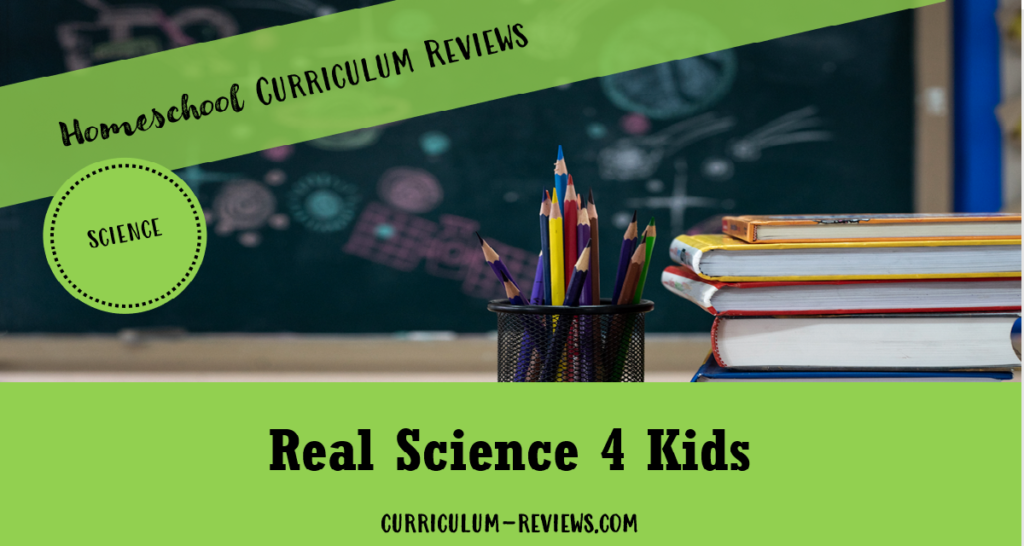
Real Science 4 Kids
Target Grade Level: Elementary (1st – 5th) and Middle School (6th – 8th)
Real Science 4 Kids offers curriculum options for the following science subjects:
- Astronomy
- Biology
- Chemistry
- Geology
- Physics
You can purchase the Focus On series that take a year-long deep dive into each one of the the scientific disciplines. The following review is based on the Focus On series. You also have the option of buying the Building Blocks series, which spirals kids through each of the five scientific disciplines each year. Building Blocks is a better choice for children who benefit from repeated exposure of material and incremental learning, year after year.
We’ve been through plenty of science curriculum and learning supports. From living books to documentaries, Bill Nye to NIH free resources, Singapore Science to mom-designed courses, we’ve tried a range of ways to bring science to life while teaching sound scientific thinking. For the evolution-teaching family, the options designed for homeschoolers (simpler labs, generally) are fairly slim. Even with a disturbingly well-equipped home lab, it’s a stretch to use regular classroom texts at home.
So initially, I welcomed Real Science 4 Kids, by Dr. Rebecca Keller. It didn’t teach evolution, but it didn’t teach creationism or intelligent design either, and since our introduction to the series was Chemistry Level 1, I wasn’t initially concerned with that omission.
At this writing, Real Science 4 Kids consists of 3 levels, each with a varying number of topics. I’ll limit my discussion to Level 1 Chemistry and Biology, since these are the only books I’ve used with enough rigor to evaluate them. My older son did the first chapter of Chemistry Level II some years back, but that’s an insufficient experience by which to gauge that series and is under complete revision.
All the Level I subjects require a textbook, a lab workbook, and a teacher’s guide. The teacher’s guide contains some notes on running the experiments, answers to all the questions, and some additional information on the subject matter. The texts are attractive, multi-color hardbacks with large font, which is easy on young and old eyes. Each text consists of ten chapters that align with ten labs and a few brief questions about the chapter, both of the latter found in the lab book. At full retail, a year of science (Chemistry, Biology, and Physics) for Level I runs about $216 new. That’s a pretty pricey elementary science curriculum. Used copies abound, but a new lab book for each student is necessary unless the child uses a separate notebook to do the written work.
The books are attractive for kids and parents and hold resale well (good, given their high price). The experiments are highly homeschooler-friendly, requiring (mostly) basic household items, although a bit of specialty shopping online is needed for a few labs (a voltmeter for Physics and living protists and Red Congo stain in Biology, for example). Two of the labs for Biology require planning and introduce animal life into your home: raising tadpoles into frogs and observing butterflies develop from caterpillars. The first results in pets that are likely to live beyond when your children go to college (We did the tadpole thing on our own four years ago. The frogs are still with us, and, according to a biologist friend, likely to spend up to 30 years with us. No more experiments that require estate planning.) The second requires timing your lab to meet shipping regulations of butterfly egg sellers. These are exceptions, however, and one could omit growing living creatures that need prolonged care with a decent video or book on metamorphosis.
The labs book also contains a few questions about the text material. Most of these are definitions or classification questions, and only on the most basic parts of the books material. Few if any require any critical thinking about the subject, making connections between topics, or analysis of information. This is a serious downfall of the series.
I think Real Science 4 Kids continues to grow in the homeschooling community because it introduces high-level vocabulary to young children. Sure, throughout Chemistry, you’ll see atoms and molecules introduced, however there’s no discussion of states of matter, a basic of any chemistry education. Instead, this text includes titration, polymers, starches, cellulose, kinesin, along with dozens of other chemistry topics. They’re interesting, but without a better grounding in chemistry basics, they’re like building a house on a sand — it’s just not going to stand.
On the whole, I found the chapters to be little more than 4 to 5 page introductions to a large subject with little focus on the hows and the whys. Science is far more that what. Science requires an understanding of how the world works and a grounding in scientific thinking. I’d rather see far less terminology and far more grounding in the basics of the way the world works along with the tools to think like a scientist. I’d like to see more inquiry based learning, where the learner asks a question and, with a good amount of guidance initially, figures out how to design an experiment to answer the question. I’d like to see discussion of controls and variables as well. Singapore Science does these well, teaching scientific thinking grounded in the basics of matter and energy.
In short, Real Science 4 Kids is an attractive product with labs geared toward the homeschool family. It’s expensive and won’t span too many years of science education, and it tends to focus on vocabulary acquisition rather than deep understanding. It’s free of any references to evolution or the origin of life, which sells books but also, in my opinion, leads to an incomplete education if used as the only biology or astronomy text.
I’d like to say I’ve found something equally easy to use at home with greater depth and an undercurrent of evolution, but I haven’t. Singapore Science, with modifications to many labs, is a better bet, in my opinion, but that’s a fairly large task. A recent find from the American Chemical Society, Middle School Science, is a far superior chemistry offer, and is online for free. It’s inquiry-driven, the supplies for labs are easy to obtain, and it is the most sound chemistry program I’ve ever seen.

About the Author: For over two decades, Dr. Rebecca Woodbury (Keller) has been exploring the ways students learn. Starting out as a research scientist in the field of biophysical chemistry, she left academia to create quality educational support materials for students and educators. She started Gravitas Publications Inc. in 2003 and introduced the Real Science-4-Kids product line for home and classroom educators to provide informative, activity-based science curricula for kids K-8.


